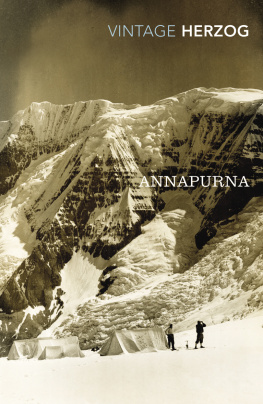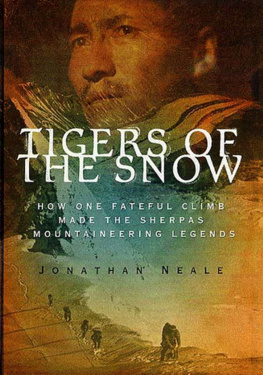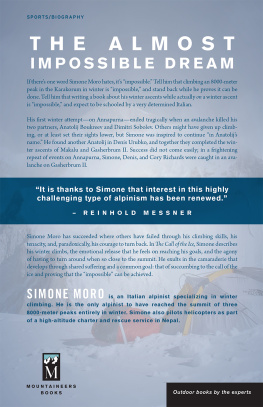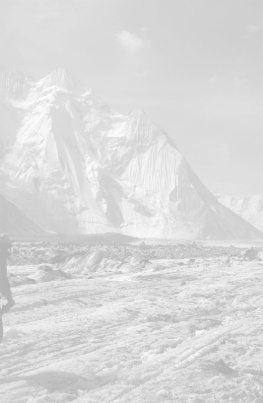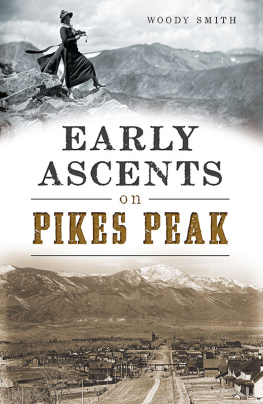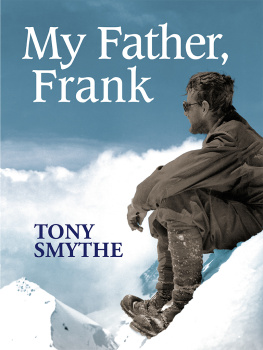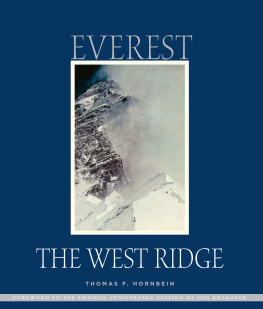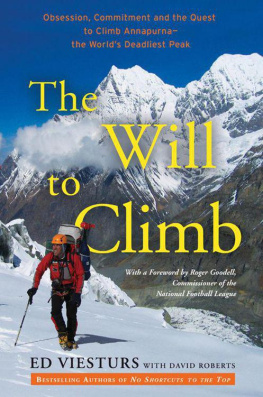Contents
About the Book
In 1950, no mountain higher than 8,000 meters had ever been climbed. Maurice Herzog and other members of the French Alpine Club resolved to try. This is the enthralling story of the first conquest of Annapurna and the harrowing descent. With breathtaking courage and grit manifest on every page, Annapurna is one of the greatest adventure stories ever told.
As well as an introduction by Joe Simpson, this new edition includes 16 pages of photographs, which provide a remarkable visual record of this legendary expedition.
About the Author
The distinguished French mountaineer Maurice Herzog was leader of the 1950 expedition to Annapurna. He was one of the two climbers to reach the summit.
List of Illustrations
First Section
. AT TANSING, APRIL 11TH, 1950 Standing, left to right: LACHENAL, COUZY, SCHATZ, OUDOT, TERRAY, HERZOG, NOYELLE, AND THE SHERPAS, PANSY, SARKI, AJEEBA, AILA, DAWATHONDUP Sitting: RBUFFAT, ICHAC, AND THE SHERPAS, PHUTHARKAY, ANGTHARKAY AND ANGDAWA
. ANGTHARKAY PAYS OFF THE PORTERS WHILE HERZOG, SCHATZ, TERRAY, NOYELLE AND, BEHIND HIM, LACHENAL, LOOK ON
. TUKUCHA, HEADQUARTERS OF THE EXPEDITION
. HOUSES IN TUKUCHA
. DHAULAGIRI AND TUKUCHA PEAK FROM THE EAST
. FIRST RECONNAISSANCE IN THE DAMBUSH KHOLA, NORTH-EAST OF DHAULAGIRI
. CAMP HIGH UP THE VALLEY OF THE DAMBUSH KHOLA: THE NILGIRIS IN THE BACKGROUND
. 15,000 FEET UP, ABOVE THE DAMBUSH KHOLA, HERZOG CATCHES SIGHT OF ANNAPURNA, BARELY VISIBLE IN THE CLOUDS BEHIND THE NILGIRIS, ON THE RIGHT OF THE PHOTOGRAPH
. THE GREAT ICE LAKE ON THE TILICHO PASS, WITH GANGA PURNA IN THE BACKGROUND
. VILLAGE AND VALLEY OF MANANGBHOT
. CHAHAR, 12,000 FEET, WHERE PILGRIMS MAKE THEIR LAST HALT BEFORE ARRIVING AT THE SACRED SPRINGS OF MUKTINATH
. ANNAPURNA, SHOWING THE ICE CLIFFS OF THE SICKLE GLACIER AND THE COULOIR BY WHICH HERZOG AND LACHENAL FINALLY REACHED THE SUMMIT. THE AVALANCHE HIDES CAMP II
Second Section
. HERZOG ON THE NORTH-WEST SPUR OF ANNAPURNA
. EVENING AT CAMP I
. SHERPAS AT CAMP II WITH THE CAULIFLOWER RIDGE IN THE BACKGROUND
. CAMP III AMONG THE SERACS
. ON THE WAY TO CAMP III. THIS PHOTOGRAPH CONVEYS MANY OF THE DIFFICULTIES THE PARTY HAD TO CONTEND WITH ON THE ASSAULT. THE CLIMBERS ARE KNEE-DEEP IN NEW SNOW, NOT YET CONSOLIDATED AND THREATENING TO AVALANCHE; WHEN THEY REACH THE ICE-WALLS THE EXHAUSTING WORK OF STEP-CUTTING WILL BEGIN, AND THE SUN BEATS DOWN MERCILESSLY
. A SHERPA CROSSING THE ICE SLOPE BELOW CAMP IVA AT ABOUT 23,000 FEET
. NORTH FACE OF ANNAPURNA, SEEN FROM THE BUTTRESSES OF THE GREAT BARRIER
. Inset FACSIMILE OF HERZOGS MESSAGE ANNOUNCING THE DECISION TO ATTACK ANNAPURNA BY THE NORTH GLACIER AND GIVING ALL MEMBERS OF THE EXPEDITION THEIR ORDERS
. THE SNOW-BLINDED TERRAY RETURNING TO CAMP II SUPPORTED BY ANGTHARKAY, WITH SCHATZ HOLDING THE ROPE. BEHIND THEM COMES LACHENAL, HELPED BY TWO SHERPAS, AND HIGHER UP ARE COUZY AND A SHERPA
. AJEEBA CARRYING HERZOG ACROSS THE FLOODED MIRISTI KHOLA
. RBUFFAT BEING TAKEN DOWN ON A SLEDGE FROM CAMP II BY SCHATZ AND FOUR SHERPAS
. BETWEEN CAMP I AND BASE CAMP SARKI (LEFT) HELPS THE PORTER WHO IS CARRYING HERZOG IN THE CACOLET
. THE RETURN BY THE MIRISTI KHOLA IN THE MONSOON
. THROUGH THE PADDY FIELDS
List of Maps
. Central Nepal
. The Ridges of Dhaulagiri
. The Annapurna Range
. Main Annapurna Range
. Annapurna seen from Camp I
. Route of the Final Assault
All Photographs courtesy M. Ichac except Camp Iva, courtesy G. Rbuffat
To
LUCIEN DEVIES
who was one of us
Introduction to the Pimlico Edition
by
JOE SIMPSON
Maurice Herzogs Annapurna is for me quite simply the greatest mountaineering book ever written. I read it first at the age of fourteen, more than twenty years after it was published in 1952, just a few months before Hillary and Tenzing became the first to reach the summit of Everest. It was an immediate best-seller, probably surprising its publishers, Cape (also now my publishers), with a sale of 40,000 copies in the few weeks leading up to Christmas. I was a schoolboy at the time and had no ambitions to become a mountaineer; the very idea terrified me. I had no real understanding of what Herzog and his team had achieved, yet the book had a profound effect on me. I felt mentally and emotionally drained by the experience of reading it. I knew, intuitively, that here was something truly exceptional; something that words could never even begin to describe. I sensed that these men had experienced such an intensity of living as to be almost inconceivable. Although frightened by the obvious perils of mountaineering, I think it was this book that led me into what has become a life-long affair with the worlds great mountains.
Twenty-two years later I re-read this classic. By that time I had climbed all over the world and gained the knowledge of how it feels simply to be alive in these awesome places, and possess a powerful sense of how fragile yet strong, how vulnerable and invincible they can make you feel. I had half-expected to be disappointed, assuming that earlier the book had impressed me because I was a child and unenlightened as far as mountains go. Now I knew all about Lachenal, Terray and Rbuffat. I had read about their legendary exploits in the Alps and farther afield. They are all gone now; only Herzog survives out of those four beleaguered men who had fought their way off Annapurna, exhausted, terribly frostbitten, snow-blind and so very close to death.
Herzogs summit companion, Louis Lachenal, died in a skiing accident, barely able, it would seem, to cope with the end of his climbing career. Outside the Alpine world he was like an eagle with clipped wings , as his great friend Terray described him. After Annapurna, sixteen operations and serious amputations ensured that he would never climb at the highest standards, never again experience that old feeling of moving in a fourth dimension, of dancing on the impossible. His brilliance, his genius for being exceptional, could never really cope with strictures of disabled clumsiness.
Lionel Terray who, with Lachenal, formed one of the greatest climbing partnerships in post-war Alpinism, continued his mountaineering career after Annapurna with successful expeditions to Makalu, Jannu, Fitzroy, Denali and extreme ascents in the Peruvian Andes. Ironically Terray, who suffered so much with Rbuffat as they tried to save the summiteers, was killed in one of those avoidable rock climbing accidents when a slip on easy ground in the Vercors, in France, led him and his partner into a fatal fall in 1965. At least we were left the consolation of his superb autobiography, Conquistadors of the Useless.
Gaston Rbuffat recently succumbed to cancer, having carved out a career in his native Alps as one of the greatest mountain guides of his generation. He was a multi-talented man, succeeding as a company director, popular as a lecturer, mountain photographer and successful alpine writer.
By contrast, Herzog seems indomitable. Always ambitious and a born leader, he forged a new life from the mutilation of his past, successfully immersing himself in public life as Mayor of Chamonix, President of the French Alpine Club, and holding parliamentary office as representative of Sports.
It was Herzogs drive and leadership, and his astonishing determination that enabled he and Lachenal to become the first men to climb an 8,000-metre mountain. They made the ascent of Annapurna without oxygen and very nearly in a single Alpine-style push. By the time they had found the mountain and discovered a feasible way of climbing it, they had no more than twelve days before the monsoon swept in from India. They reached the summit with barely twenty-four hours to spare. Even today such a climb in that time scale would be an exceptional feat. In 1950 it was quite extraordinary, and it contradicted all the opinions of the so-called experts of the day. But what a fearful price they had to pay for their impudence.
Next page
